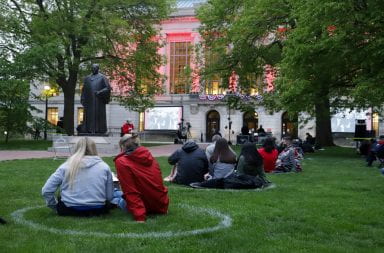When Ohio State was founded, there were crops growing in the area around The Oval. Thanks to one OSU art professor, the Wexner Center for the Arts is reliving a bit of OSU’s agricultural history with live sheep.
Michael Mercil, an associate professor of art, will bring his three Shetland sheep to campus one day each month as part of a new exhibit that pairs animal husbandry with art.
“The Virtual Pasture” inhabits 500 square feet just outside the Wexner Center. The ground has been fenced in and has been planted with bluegrass, white clover and apple trees.
Since the live sheep are only in residence the first Monday of each month, a life-size cutout will always be on display. A screen with a live video feed will allow visitors to monitor the sheep when they’re at home on his Delaware County farm.
The exhibit draws on a growing desire among artists to be more socially aware about agriculture, said Karen Simonian, spokeswoman for the Wexner Center.
“It fits in with a lot of concern that contemporary artists are having right now with the food industry and the connection we have with the natural world,” she said.
It also allows for collaboration across the university. Besides the Wexner Center, the project involves the Department of Art and the College of Food, Agriculture and Environmental Sciences.
Mercil is no stranger to unconventional art. He previously used the same space outside the Wexner for another agricultural art project entitled “The Beanfield.” Mercil also spent time on 365 nonconsecutive days sitting on The Oval and reading sections of “The Columbus Dispatch” aloud.
Simonian said that since Mercil is nationally renowned for his work, and the Wexner Center was happy to work with him again.
“When his next idea for a virtual pasture came up, it seemed like a natural fit,” she said. “It fits with the land-grant history of the university.”
Simonian said that the work has already generated lots of chatter from passers-by, and has even led to comments posted on a knitting blog.
“It’s a provocative piece,” she said. “It’s a project that sparks a lot of dialogue.”
The outdoor exhibit is accessible 24 hours a day, though the live sheep will be displayed the first Monday of the month from 10 a.m. to 3 p.m. The exhibit currently does not have a set finish date and is expected to run through the spring.


